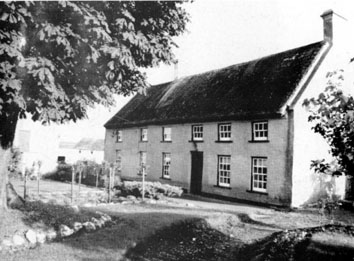Waringfield House
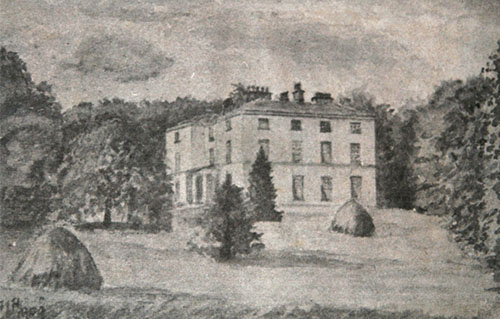
Waringfield House
As one travelled out of the village in the direction of Magheralin, there stood Waringfield House, another notable Georgian building. It was the residence of the Waring family who in 1876 owned more than two thousand acres at Moira. That house is long gone but the perimeter of the walled garden is still visible and included in the residential development now on the site.
Waringfield was clearly a beautiful location and nearby is Pretty Mary’s Fort. Canon Rudd in his book[1] quotes this extract from the poem – “Pretty Mary’s Fort”
I have read about Killarney’s Lakes
I have seen Shane’s Castle Hall
But the beauty of you Waringfield
You far exceed them all.
Long may the name of Waring live there
In this ancient Hall to reign
And keep an eye unto the poor
That live round his domain.
We bid adieu to Waringfield
With it’s laurels ever green
And to the weeping willows
Down by the Lagan stream.
And to the Forth and Burns’ house
And pretty Mary’s well –
To describe the beauties of this place
No human tongue can tell.
Gabriel Beranger described a visit to Warringsfield (sic) with Miss Sharman.
I saw, for the first time, glass bee-houses; they are made conical and covered with cones of straw, to make them dark, otherwise, I was told, the bees would not work. The hives stand in a kind of wooden press, in the middle of a garden. This press had small holes in the doors, to let in the bees, from whence they enter the hives. To show them, the doors of the press are opened, and the straw covers taken off, when I saw the bees at work against the sides. Mr. Warring has got the method from France of taking the honey without destroying these useful and ingenious insects.
In June 1942, during World War II, the American military constructed a nine hundred bed convalescent hospital at Waringfield for the British Emergency Medical Service (EMS). It was to grow to one thousand beds the following year. Wounded soldiers from all parts of the world were treated at this hospital. Ambulances were always on standby awaiting the arrival of casualties at Maghaberry Airfield. For some time Waringfield was also the base for a Company of French soldiers.[2]
When the Ulster Military Hospital was transferred to Musgrave Park Hospital, the Royal Army Medical Corps presented their flag to Moira Parish. The buildings later became a geriatric hospital. Waringfield House was destroyed by fire and finally demolished in the late 1980’s.
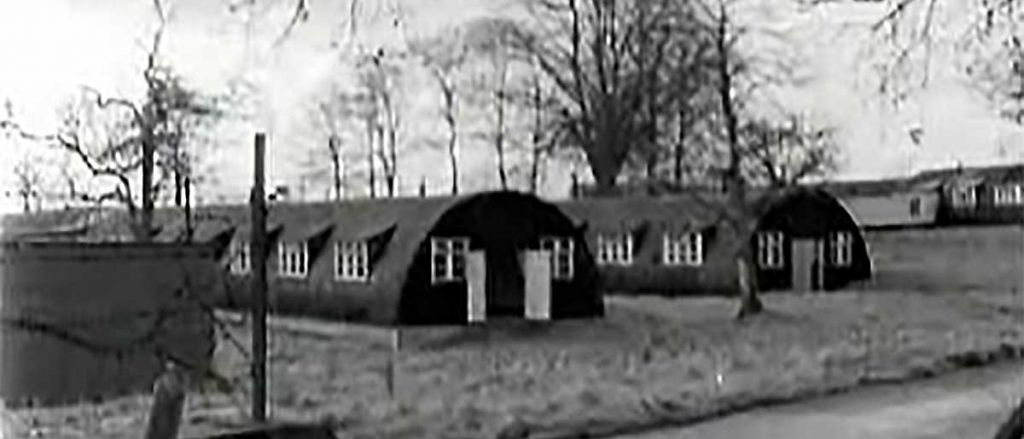
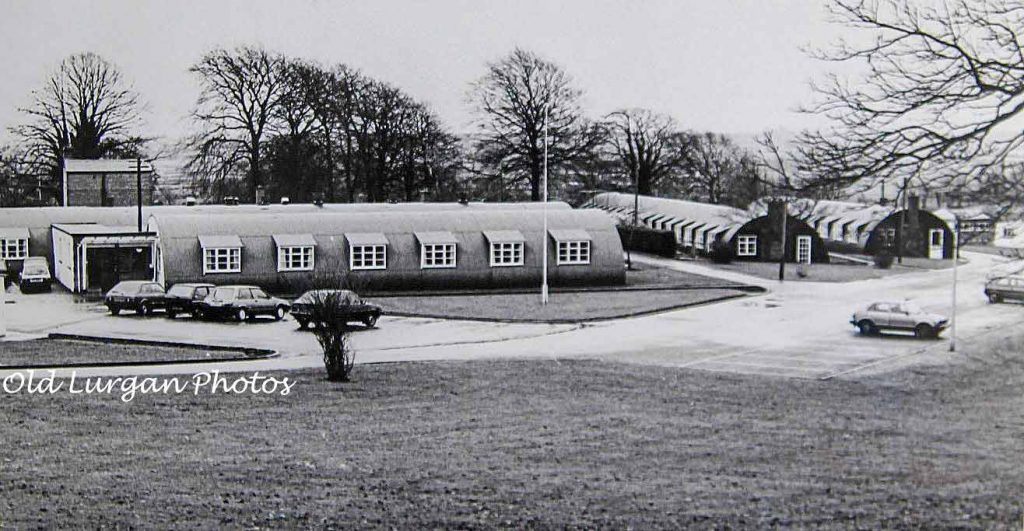
Waringfield Hospital – kindly shared by Old Lurgan Photos
Trummery House
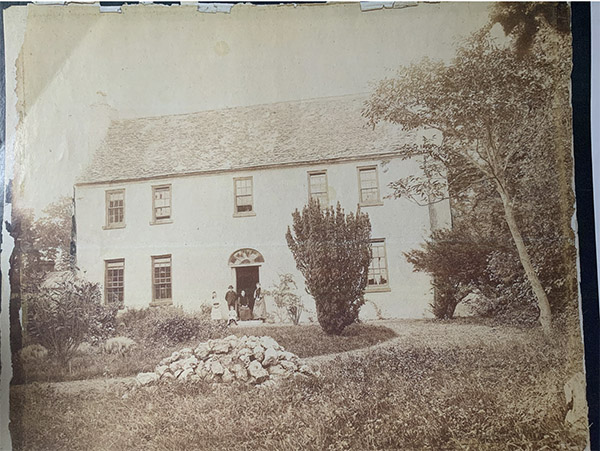
Trummery House
Trummery House, a short distance from Moira on the Lisburn Road, was built in 1625 so it pre-dates Rawdon settling in Moira. It was the home of Captain Henry Spencer, an army officer in 1598 who was granted four square-miles of land in the area under lease from Queen Elizabeth I. He was governor of the Fort of Inisloughlin. It is said that in 1690 of King William III would ride over from Hillsborough to discuss the military situation with Captain Spencer and dine with him at Trummery House. But I have a problem with that. William lll’s visit to Hillsborough was fleeting, perhaps only one night.
Also at that time, Trummery House quite possibly was the home of Archibald Bell and family. Bell had been in Ireland for a short time with Cromwell’s army in 1649 but returned from Scotland in 1655, residing in the Armagh area and eventually settling in Trummery. He would have been a contemporary and neighbour of George Rawdon but certainly not a friend. George Rawdon assiduously followed instruction to persecute dissenters. Records show that in 1666 Archibald refused to pay tithes and so seven sheep worth 14 shillings were taken from him. He became a Quaker in 1667 and an elder in 1676 and the following generations continued to suffer discrimination. Archibald died in Trummery House in 1707 aged 87 and is buried at Maghaberry, probably in the old Friends burial ground.
Two of Archibald’s son became tanners and that was the family trade through six generations. But it would seem from Samuel Lewis’s records in 1837 that the weaving of linen and cotton was carried on there. Archibald’s six-times great-granddaughter was the one who would become his most illustrious descendent. Dame Professor Jocelyn Bell Burnell, born in Lurgan, would become the renowned astrophysicist who discovered pulsars.
Like many grand homes of the time Trummery House was said to have an escape tunnel that ran to Trummery graveyard. Early nineteenth century maps show extensive buildings, gardens and avenues but all traces of these are now gone. A tree-lined avenue led from the house to the Hillsborough Road at a point close to Boyles Bridge. To this day a lane follows the line of that avenue but the main entrance was moved to the Lisburn Road before the start of the 20thC. That part of the Hillsborough Road became known as the Avenue Foot and in the last century was a popular meeting place for all ages on a Sunday afternoon.
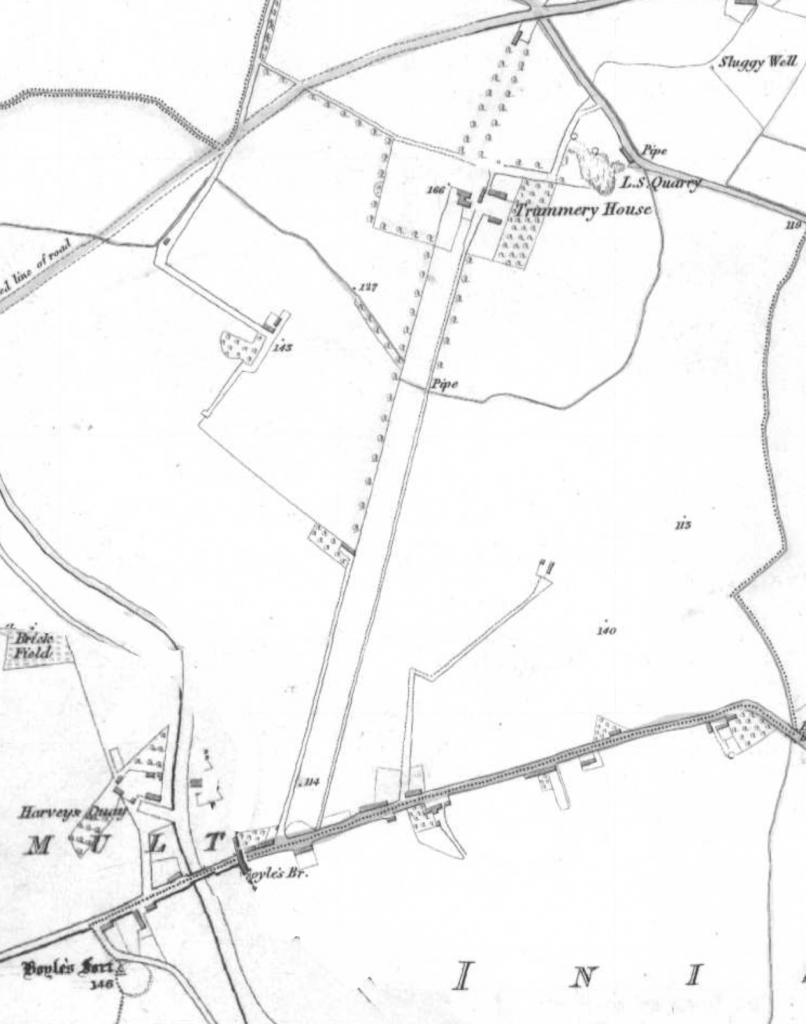
Both houses listed above are long gone but Moira today still has some buildings that give us a flavour of how our village looked nearly three hundred years ago. A number of them date from the time of the Rawdons or their successors.
Berwick Hall
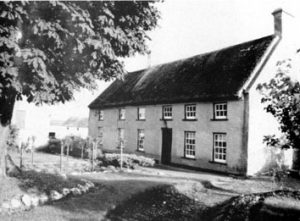
The earliest Moira building that is still occupied is Berwick Hall, the two-storey “Planters” thatched house on the Hillsborough Road. According to the present owner, the building dates back to 1697 and is Category A listed. It was owned by the Berwick family who lived in the area since the Battle of the Boyne or even earlier. The house is an extremely fine example of a yeoman’s home. Members of the Berwick family lived live there until the 1860s. George Wilson bought it in 1861 and his descendents still reside there.
Magherahinch House
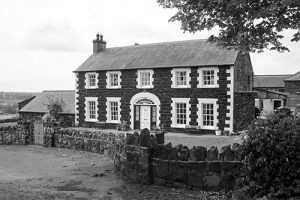
Magherahinch House
Down the lane beside the former Police Station lies the beautiful Magherahinch House. This secluded location keeps this gem well hidden but it is a very notable building. It affords majestic views down the Lagan Valley to the village of Hillsborough with which it has links.
It is a five-bay two-storey stone and brick double-pile house. The front pile facing east was built in 1838 but the rear pile was built c.1720.[3]
The older part of the house is first mentioned in a will of John Bateman dated 1754, who left his “freehold estate in Magherahinch with my house and gardens thereon” to his dear wife Dorcas and thereafter to his son William Bateman.
The house is mentioned in the Post-chaise Companion of 1786, “Near Moira and on the west of it, is the seat of John Bateman Esq. standing on an eminence and having a beautiful prospect of wood and the meanders of the river Lagan.”[4]
In 1833 the Marquess of Downshire purchased the property and in 1838 he added an additional block on to the front of the old house. A datestone and the Downshire coronet adorn the building. It is suggested that the Marquess used the house as a country retreat though he lived a mere six miles (10 km) away as the crow flies. Over the next one hundred years the house was leased to wealthy farmers including Joseph Green and his brother, Adam Agar and James Turner until, in 1929 the house was sold to Joseph Cresswell for £5000.[5]
Douie House
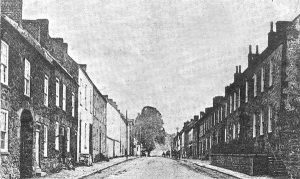
Douie House on the right
Number 106 Main Street is now known as Beaufort House and is used for a business but the building was once the home and office of the land steward for the Moira estate. It is believed to date from 1760.
Kilmore House
Though a little under three miles out of the village, Kilmore House had a role in one lasting facet of Moira life. The original house was a Rectory built in 1750. Whether this belonged to Magheralin or Moira is unclear but on editions of the Ordnance Survey map of 1833, this building is labelled as the Old Rectory.[6] The rectory is long gone but the Langtry family built Kilmore House there in 1854. Its owner was George Langtry, a merchant from Lurgan, who went on to bigger and better things. He bought Fortwilliam in Belfast in 1810 and became a renowned Belfast shipping magnate in the city.
Anne Lutton, founder of Methodism in Moira, loved Kilmore and often visited her friends there. Miss Elizabeth Langtry was a “lady of good social position, intellectual tastes” and considerable attainments and she became a confidante and intimate friend of the young Anne as she began her Methodist ministry in the village and far beyond.[7]
A very different lady had associations with Kilmore House. George Langtry’s grandson Edward married Lily in 1874 and she is notorious for being the mistress of the Prince of Wales, later to become Edward VII, as well as having a string of other liaisons. It is not surprising that Edward Langtry ended his days in what was then called a lunatic asylum.
Rectory
It would seem that Moira once had a glebe house as well as a rectory. First edition Ordnance Survey maps in 1833 show a Glebe house where the old rectory now stands as well a Rectory marked on the land between Earlsfort and the detached houses on the Lurgan road. The Rectory was not marked on OS Maps dated 1860 so perhaps the Glebe House had become home for the Rector.
The Glebe house was built in 1799 at a cost of £710.[8] At some point it began to be referred to as the Rectory and was lived in by the clergy but was not captioned “Rectory” on maps until 1903.
The house appears to have been built in stages; a stone above the ceiling in the kitchen is dated 1811 and a bay was added to the south elevation before 1858.
Before the end of the twentieth century the rectory was sold and a new rectory erected in the grounds. Although renovated and having lost some of its character, the former rectory still resembles its earlier manifestation. It is now converted into a children’s nursery.
Snippets on other buildings
The parish and village owe their existence to the Rawdon family who were largely responsible for building the houses within the village and for the village’s development. The old mud-built houses were replaced with houses built with stone. The Chinese restaurant, Midnight Haunt, opposite the Market House (Pentecostal Church) bears a stone with the date 1735. It is the kind of inscription that usually indicates the date a village was completed
Number 57 Main Street now trading as The Fat Gherkin was beside the old police station and for a time it housed the medical dispensary. Across the street, number 54, The Barrow, was a Post Office from the early twentieth century until the early 1970s. Number 50 was once the Presbyterian Manse.
In 1866 numbers 76 and 78 Main Street were referred to as ’21 Town of Moira’. From the mid nineteenth century, the building was occupied and run as a hotel by John Murphy. Later it was bought by the Ruddell family, who also owned the garage in the Market House. They ran the hotel for thirty-five years until it was bought by Susan Heaney in 1926. It became a temperance hotel, using only the property now occupied by Robert Wilson. The hotel business closed in the early 1970s.
Number 83 Main Street was once the site of a factory operated by Harry Ferguson Motors Ltd. during the second world war. He had two small production units manufacturing parts for his world-famous tractor and Bofors guns. After the war the factory was adapted by Derg Handwoven Tweeds Ltd to produce fabric.

